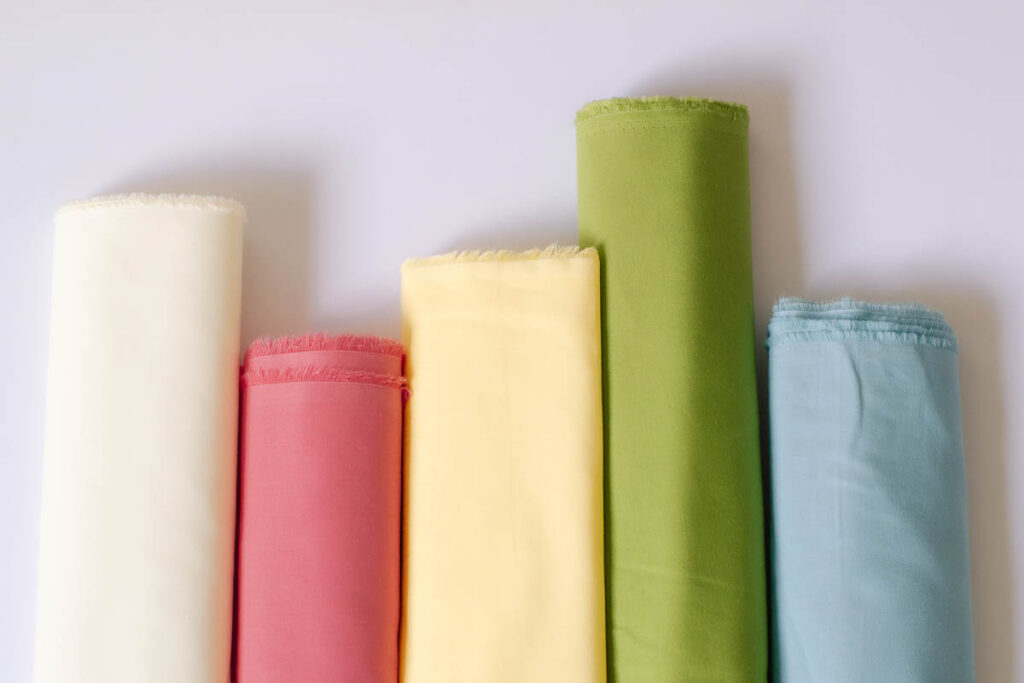
Ever find yourself thinking you need a degree in a second language just to decipher that tiny tag on your clothing? It’s a common experience—more often than not, checking the composition of a garment can leave you with more questions than answers. Navigating the world of the most popular fabrics can be a complex task, especially in today’s world. When you take a look at the clothing tag, it’s not always clear whether that fabric is a great choice for you and your lifestyle. Not to mention the environmental impact can vary between different fabrics, and understanding what the best clothing fabrics are for sustainability can be challenging.
This comprehensive guide about the most popular fabrics for clothing was created to empower you with knowledge, making it easier for you to choose the best clothing fabrics that align with your life and your values. By using this guide, you can make informed and conscious decisions while building your wardrobe. Before your next shopping trip, consider bookmarking this page for quick and handy reference.
Plant Fabrics
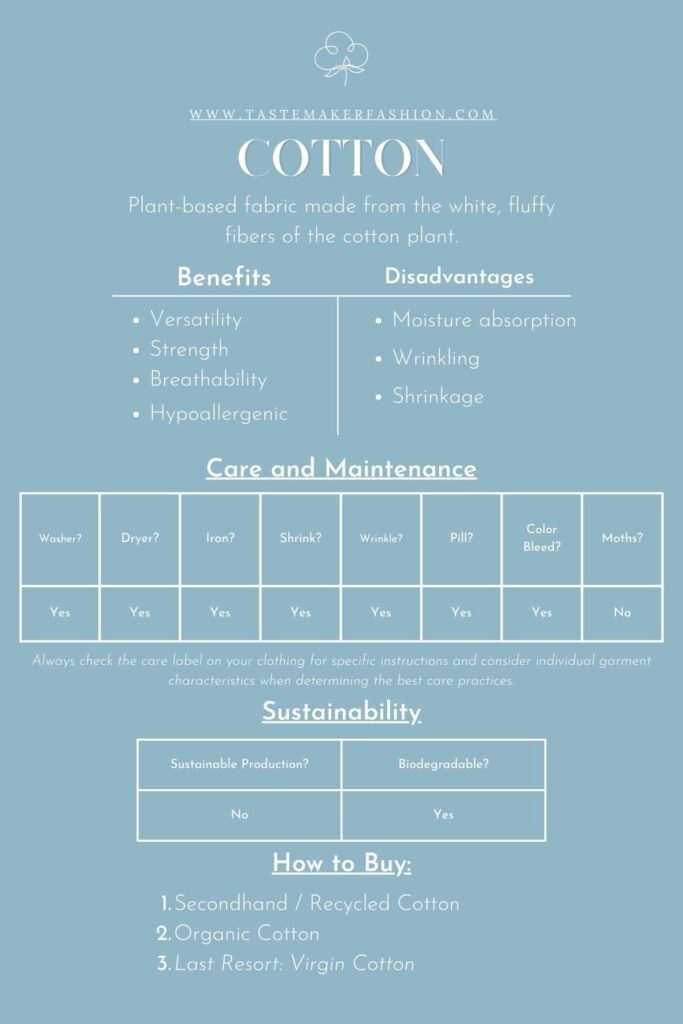
Cotton
What is Cotton?
Cotton is one of the most popular fabrics and is a natural, plant-based fabric made from the white, fluffy fibers of the cotton plant. Grown in warm climates around the world, cotton fabrics are carefully harvested and processed to create the versatile material that finds its way into various aspects of our wardrobes.
What are the Benefits of Cotton Clothing?
Versatility: Cotton’s versatility shines as it can be woven into one of the most popular fabrics ranging from denim for your jeans to poplin for blouses and jersey for knitted attire. With up to 71 different types of cotton fabrics, it proves to be one of the best clothing fabrics for various types of clothes.
Strength: Noteworthy for its strength, cotton fibers become more robust when wet. This characteristic ensures that your cotton clothing maintains its fit and durability over time, providing you with sturdy and long-lasting garments.
Breathability: Cotton’s breathable nature facilitates air circulation, keeping you cool and comfortable. This makes it one of the best clothing fabrics in warmer climates.
Hypoallergenic: Unlike wool or synthetic fabrics, cotton carries a low risk of causing skin irritations, making it an ideal option for those with sensitive skin. Opting for organic cotton further minimizes chemical exposure during production.
What are the Disadvantages of Cotton Clothing?
Moisture absorption: Cotton’s moisture-absorbing quality can lead to sweaty and smelly situations. This makes it less suitable for intense physical activities or sports where quick-drying fabrics might offer greater comfort.
Wrinkling: Cotton fabric tends to wrinkle easily, often requiring ironing or steaming before wear to maintain a polished appearance.
Shrinkage: Cotton tends to shrink, particularly when exposed to high temperatures during washing and drying processes. Care should be taken to avoid excessive heat to preserve the original size of cotton garments.
How to Care for Cotton Clothing:
| Question | Answer |
|---|---|
| Can I put my cotton clothing into the washing machine? | Yes, care for cotton by washing in cold or warm water to prevent color fading and shrinkage. |
| Can I put my cotton clothing into the dryer? | Yes, but to minimize shrinkage, use a medium heat setting. |
| Can I iron my cotton clothing? | Yes, and use steam to effectively remove wrinkles. |
| Will my cotton clothing shrink? | Yes, cotton clothes are prone to shrinking up to 3%, especially in hot temperatures. |
| Will my cotton clothing wrinkle? | Yes, cotton clothes tend to wrinkle more easily. You can help reduce wrinkling by removing it immediately from the dryer. |
| Will my cotton clothing pill? | Yes, and it is more common in shorter, looser cotton knits compared to tighter weaves like denim. Gentle washing and avoiding abrasives during wear can help minimize pilling. |
| Will my cotton clothing bleed when washed? | Yes, cotton does not hold dye as well as other fabrics, making it susceptible to bleeding and fading over time. Separating dark and light colors, especially during the first few washes, will help preserve the color. |
| Is my cotton clothing prone to moths? | Not as much as other keratin protein fibers. Cotton is less attractive to moths, but it is essential to store clothing in a clean, well-sealed environment to prevent damage. |
Remember, always check the care label on your cotton clothing for specific instructions and consider individual garment characteristics when determining the best care practices.
Is cotton production sustainable?
Cotton, while a natural and versatile fabric, raises concerns regarding its environmental impact. Unfortunately, cotton production is not sustainable. The process of cultivating this crop is notably water-intensive, requiring approximately 2,700 liters of water to produce a single cotton shirt.
To put this into perspective, consider that the recommended daily water intake for an individual is around 8 glasses or 2 liters. If we were to consume this daily amount, it would take over 3.5 years to match the water consumption of producing just one cotton shirt. This staggering statistic underscores the significant water footprint associated with cotton cultivation.
Moreover, cotton farming is notorious for its heavy reliance on pesticides and other chemicals. This widespread use contributes to the contamination of local water resources, especially in major cotton-producing regions like India, Brazil, and Uzbekistan. The environmental repercussions of these practices raise concerns about water pollution and its broader ecological impact.
Is cotton biodegradable?
On a positive note, cotton, being a natural fiber, holds an advantage in terms of biodegradability. Cotton can decompose within a relatively short time frame—ranging from one week to five months, as long as it is made of pure cotton. This attribute aligns with a more eco-friendly end-of-life cycle for cotton-based products, although the overall environmental cost of its production should not be overlooked.
How to Buy Cotton Clothing:
When it comes to selecting cotton clothing at the store, prioritize sustainability with this ranked guide, ranging from the most eco-friendly to less sustainable options:
- Recycled Cotton or Secondhand Cotton: Topping the list for one of the best clothing fabrics, recycled or secondhand cotton represents a commendable choice. By giving new life to existing materials, you contribute to the reduction of waste and the conservation of resources.
- Organic Cotton: Opt for organic cotton, and be on the lookout for certifications like the Global Organic Textile Standard (GOTS) or Organic Content Standard (OCS). Organic farming practices eliminate or minimize the use of synthetic chemicals, promoting soil health and reducing environmental impact.
Buy Virgin Cotton as a Last Resort: While it’s one of the most popular fabrics, virgin cotton ranks lower due to its unsustainable production practices. The conventional cultivation of virgin cotton often involves heavy water usage and pesticide use, contributing to environmental concerns. Whenever possible, consider alternatives like recycled or organic cotton for a more sustainable wardrobe.
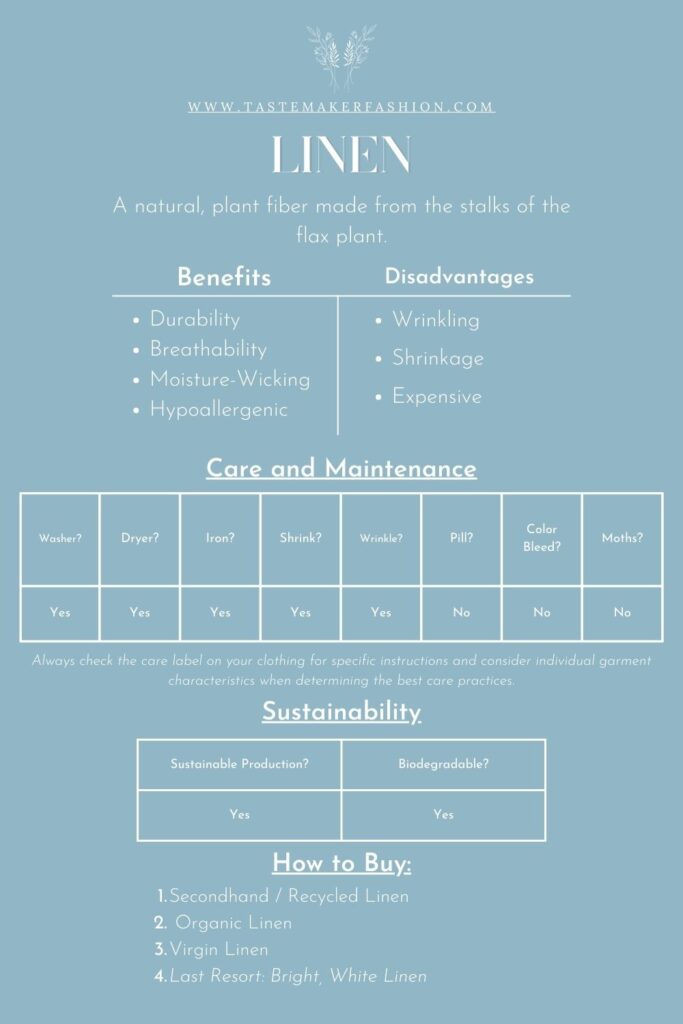
Linen
What is Linen?
Linen is a natural, plant fiber made from the stalks of the flax plant. Its roots trace back to ancient civilizations, where its remarkable qualities were cherished, making it one of the most popular fabrics for clothing. Today, linen continues to captivate with its timeless elegance, embodying a harmonious blend of nature’s simplicity and the sophistication of a fabric woven through the tapestry of human history.
What are the Benefits of Linen Clothing?
Durability and Longevity: Linen stands out for its exceptional durability, with flax fibers exhibiting strength that can extend the lifespan of linen garments up to 30 years. This factor contributes to being one of the most popular fabrics and is also a sustainable choice.
Breathability: Ideal for hot and humid climates, linen is one of the best clothing fabrics for breathability by allowing increased airflow. This property helps cool down the body, making linen a comfortable option in warm weather.
Moisture-Wicking: Linen’s natural ability to wick away moisture ensures comfortable wear by keeping the body dry. This feature is particularly beneficial during warmer seasons, preventing discomfort caused by sweat sticking to the skin.
Hypoallergenic: For individuals prone to skin reactions, especially during warmer seasons, linen proves to be one of the best clothing fabrics. Its moisture-wicking capabilities reduce the likelihood of bacterial or fungal growth, making it suitable for those with sensitive skin.
What are the Disadvantages of Linen Clothing?
Wrinkling and Creasing: One notable drawback of linen is its tendency to wrinkle and crease more easily. While some appreciate the lived-in look, others may prefer to iron out wrinkles and creases before wearing linen garments.
Shrinkage: Linen tends to shrink if not handled with care. To maintain the original size of linen clothing, it’s advisable to avoid washing and drying at high temperatures.
Cost Consideration: While linen’s strength and durability contribute to a high cost-per-wear, the manual processes involved in its production make it a more expensive fabric. Despite the luxurious feel and enduring nature, the higher price point is an aspect to consider when investing in linen pieces.
How to Care for Linen Clothing:
| Question | Answer |
|---|---|
| Can I put my linen clothing in the washing machine? | Yes, linen clothing can be machine washed. For optimal linen care, it’s recommended to keep them with lighter clothing, using a gentle cycle with warm water. |
| Can I put my linen clothing in the dryer? | Yes, linen can go in the dryer. To avoid shrinking, use a gentle cycle with low heat during the drying process. |
| Can I iron my linen clothing? | Yes, ironing linen is encouraged. Use a medium-hot iron while the linen is still damp or utilize steam to effectively smooth out wrinkles. |
| Will my linen clothing shrink? | Yes, linen clothing does tend to shrink—up to 10%—if not handled with proper care. |
| Will my linen clothing wrinkle? | Yes, linen is prone to wrinkling. Embrace the natural texture or use an iron to achieve a more polished look. |
| Will my linen clothing pill? | No, linen does not tend to pill, ensuring a longer-lasting and smoother appearance. |
| Will my linen clothing bleed when washed? | No, linen generally holds dye well. However, it is crucial to exercise caution during the initial washes to maintain color vibrancy. |
| Is my linen prone to moths? | No, linen is less attractive to moths compared to other keratin protein fibers. While it has a lower risk, storing linen clothing in a clean, well-sealed environment is essential to prevent potential damage. |
Remember, always check the care label on your linen clothing for specific instructions and consider individual garment characteristics when determining the best care practices.
Is linen production sustainable?
Linen stands out as one of the best clothing fabrics and is also one of the most sustainable. Particularly when compared to cotton, linen boasts significantly lower water requirements, with only 6.4 liters needed per shirt compared to the staggering 2700 liters required for cotton shirts.
Adding to its eco-friendly credentials, flax, the plant from which linen is derived, is robust and resilient, thriving in challenging growing conditions. Notably, linen production involves the use of considerably fewer pesticides than alternative materials, contributing to a more sustainable agricultural process.
Is linen biodegradable?
Linen is biodegradable and 100% linen can decompose in as little as two weeks. This rapid decomposition underscores the natural and sustainable end-of-life cycle of linen, aligning with environmentally conscious practices and reducing its long-term impact on the planet.
How to Buy Linen Clothing:
If seeking linen clothing in stores, prioritize sustainability with this ranked guide, ranging from the most environmentally conscious to less sustainable options:
- Recycled Linen or Secondhand Linen: At the top of the list for most popular fabrics, recycled or secondhand linen embodies a commendable choice, contributing to the reduction of waste and promoting resource conservation.
- Organic Linen: Opt for organic linen, and look for certifications such as the Global Organic Textile Standard (GOTS) or European Flax® Certification. This ensures that the linen is produced using environmentally friendly practices, without harmful chemicals.
- Virgin Linen: If new linen is your preference for best clothing fabrics, choose virgin linen in natural shades. These hues generally require less intensive bleaching processes compared to bright whites, reducing the environmental impact.
Avoid buying Bright, White Linen: Bright white linen, often undergoes an intensive bleaching process. To minimize environmental impact, it’s advisable to steer clear of these extensively processed options in favor of more natural shades.
Animal Fabrics
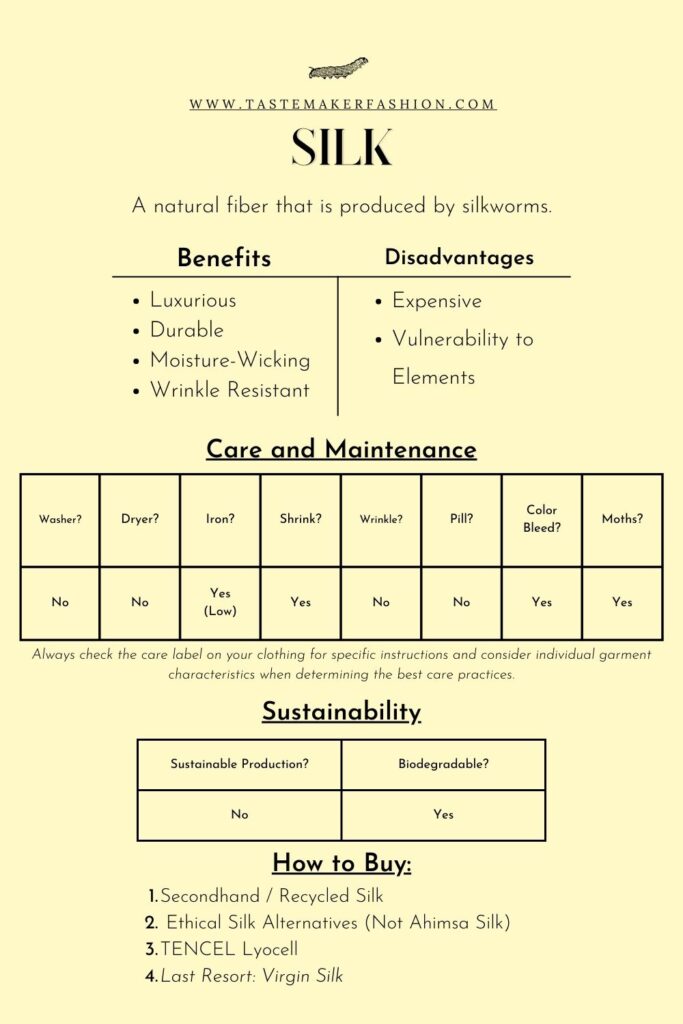
Silk
What is Silk?
Silk stands as one of the most popular fabrics and is a natural fiber that is produced by silkworms. The silk production process begins with the cultivation of silkworms, where they craft protective cocoons. Harvesting these cocoons precedes the transformation of silkworms into moths, a step achieved through a boiling process that unfortunately results in killing the silkworms inside. Notably, it takes approximately 3,000 cocoons to produce just one yard of this most luxurious fabric.
What are the Benefits of Silk Clothing?
Luxurious: Silk fabric is one of the most popular fabrics and gives off a beautiful, luxurious sheen that offers comfort and lightweight wear as a garment.
Durability: Silk fibers exhibit remarkable strength, allowing them to stretch without warping or sustaining damage. This makes them one of the best clothing fabrics and ensures that silk garments maintain their integrity and luxurious appeal over time.
Moisture-Wicking: Characterized by its hydrophobic nature, silk helps regulate body temperature in hot weather, providing a fresh and comfortable feel by wicking away moisture.
Wrinkle Resistance: Thanks to its inherent durability, silk resists wrinkling, making it an excellent option for those who prefer garments that stay smooth without frequent ironing.
What are the Disadvantages of Silk Clothing?
Cost Consideration: The luxurious quality of silk comes at a price, reflecting the intensive production process involved in creating this fabric.
Vulnerability to Elements: While silk is a strong fiber, it remains susceptible to water and sunlight. Even the slightest water droplet can leave an irremovable stain, and exposure to sunlight weakens the fiber, making it prone to rips and fading. Proper care is essential to maintain the longevity and pristine appearance of silk garments.
How to Care for Silk Clothing:
| Question | Answer |
|---|---|
| Can I put my silk clothing in the washing machine? | While washing silk by hand is the safest option, if needed, you can use a mesh bag and a delicate cycle in the washing machine. |
| Can I put my silk clothing in the dryer? | No, avoid putting silk in the dryer as it can damage the silk fibers and lead to shrinkage. |
| Can I iron my silk clothing? | Yes, but use the lowest setting and avoid steam to prevent potential damage to the delicate fabric. |
| Will my silk clothing shrink? | Yes, silk tends to shrink, with a potential reduction of up to 5%. |
| Will my silk clothing wrinkle? | No, silk is not prone to wrinkles, although it lacks the wrinkle resistance seen in synthetic fibers. |
| Will my silk clothing pill? | No, due to the length of the silk thread, it is highly resistant to pilling. |
| Will my silk bleed when washed? | Yes, silk may bleed dye during washing. For initial washes, it’s advisable to wash silk separately or with similar colors. |
| Is my silk prone to moths? | Yes, silk is especially susceptible to moths due to its fibrous protein, keratin. Proper storage in a clean, sealed environment is crucial to prevent potential damage from these pests. |
Remember, always check the care label on your silk clothing for specific instructions and consider individual garment characteristics when determining the best care practices.
Is silk production sustainable?
Regrettably, silk production is not deemed sustainable, primarily because the conventional process involves the killing of silkworms during the cocoon harvesting phase. An estimated 1.2 trillion silkworms are boiled to death annually to sustain the silk industry. This aspect raises ethical concerns and underscores the need for alternative, more humane practices in the silk production industry.
Is Peace Silk sustainable?
Peace Silk, also known as Ahimsa Silk, is not a straightforward, sustainable option. While it is considered a more ethical choice than conventional silk because it allows silkworms to mature and emerge from their cocoons without being boiled alive, there are ethical concerns in the breeding and care of the moths.
Frequently, moths are bred until their fertility decreases, after which they are left to die due to improper care, leading to a diminished quality of life. This brings to light the complexities and ethical considerations involved in the production of silk production.
Is silk biodegradable?
Despite the sustainability challenges in its production, silk is biodegradable. However, it’s important to note that pure silk, known for its incredible durability, may take about four years to decompose. This emphasizes the importance of responsible disposal practices to minimize the environmental impact of silk.
How to Buy Silk Clothing:
When shopping for silk clothing as one of the most popular fabrics, consider these options ranked for sustainability:
- Recycled Silk or Secondhand Silk: With its inherent durability, recycled or secondhand silk is one of the best clothing fabrics for adding luxury to your wardrobe and giving it a second life.
- Ethical Silk Alternatives: Explore innovative alternatives like Citrus Fibre and Vegan Spider Silk for ethical silk options that align with sustainable practices.
- TENCEL Lyocell offers luxurious qualities akin to silk while boasting of a more sustainable production process. It’s an eco-friendly alternative with a reduced environmental footprint.
Buy Virgin Silk as a Last Resort: Opting for the alternatives mentioned above not only supports sustainability but also encourages ethical practices in the silk industry.
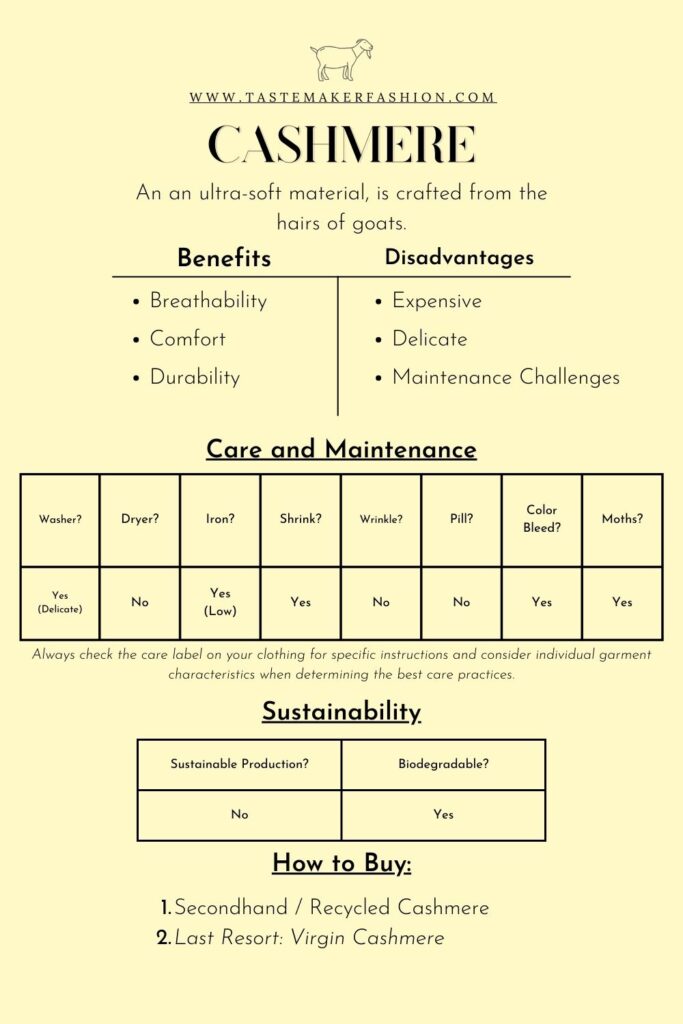
Cashmere
What is Cashmere?
Cashmere, an ultra-soft material, is crafted from the hairs of goats. While any goat’s hair can be used, the most coveted strands come from a specific breed aptly named the cashmere goat. These prized fibers are sourced from the underbellies of goats, primarily found in Mongolia, Southwest China, Iran, Tibet, Northern India, and Afghanistan. Once collected, the cashmere shearings undergo processing in facilities to create the luxurious textile as one of the most popular fabrics for clothing.
What are the Benefits of Cashmere Clothing?
Breathability: Cashmere, with its moisture-wicking properties, helps regulate body temperature, making it one of the best clothing fabrics for diverse climates.
Comfort: Renowned for its extreme softness and lightweight feel, cashmere provides a luxurious sensation against the skin, distinguishing it from potentially itchy wool.
Durability: High-quality cashmere, with the proper care, will maintain its softness while withstanding wear and tear, resulting in a piece that will last a long time.
What are the Disadvantages of Cashmere Clothing?
Cost: The premium price tag of high-quality cashmere reflects the resources involved in its production, underlining the meticulous combing and processing of the goat’s fine hairs to achieve the luxurious quality.
Delicate: While cashmere can be one of the most popular fabrics, it requires special care and is susceptible to damage from stretching, tears, and exposure to various elements, emphasizing the need for gentle handling to preserve its exquisite texture.
Maintenance Challenges: Cashmere requires special care making it less convenient to maintain compared to other fabrics; however, the investment in care pays off in the longevity and enduring softness of this premium material.
How to Care for Cashmere Clothing:
| Question | Answer |
|---|---|
| Can I put my silk clothing in the washing machine? | While handwashing is the safest option for cashmere care, if needed, you can use a mesh bag and a delicate cycle in the washing machine. |
| Can I put my silk clothing in the dryer? | No, avoid putting silk in the dryer as it can damage the silk fibers and lead to shrinkage. |
| Can I iron my silk clothing? | Yes, but use the lowest setting and avoid steam to prevent potential damage to the delicate fabric. |
| Will my silk clothing shrink? | Yes, silk tends to shrink, with a potential reduction of up to 5%. |
| Will my silk clothing wrinkle? | No, silk is not prone to wrinkles, although it lacks the wrinkle resistance seen in synthetic fibers. |
| Will my silk clothing pill? | No, due to the length of the silk thread, it is highly resistant to pilling. |
| Will my silk bleed when washed? | Yes, silk may bleed dye during washing. For initial washes, it’s advisable to wash silk separately or with similar colors. |
| Is my silk prone to moths? | Yes, silk is especially susceptible to moths due to its fibrous protein, keratin. Proper storage in a clean, sealed environment is crucial to prevent potential damage from these pests. |
Remember, always check the care label on your cashmere clothing for specific instructions and consider individual garment characteristics when determining the best care practices.
Is cashmere production sustainable?
Regrettably, cashmere production is not considered sustainable. While shearing doesn’t involve killing the goats, it poses ethical concerns. The shearing process, executed with sharp metal combs, can lead to wounds, and the goats, often left vulnerable in harsh winters, may freeze or face grim conditions after shearing. When goats no longer yield sufficient cashmere, they are frequently slaughtered for meat.
Is cashmere biodegradable?
Yes, natural cashmere fiber is biodegradable and can decompose within one to five years, aligning with eco-friendly disposal practices. Choosing responsible disposal methods for cashmere items further minimizes their ecological footprint and supports environmentally conscious practices.
How to Buy Cashmere:
Recycled or Secondhand Cashmere: Embracing secondhand cashmere as one of the best clothing fabrics not only reduces the demand for new cashmere production but also supports a circular economy. This promotes resource conservation and minimizing the environmental impact associated with traditional cashmere production.
Buy Virgin Cashmere as a Last Resort: Given the ethical concerns in cashmere production, avoiding new cashmere until more ethical sourcing methods emerge is advisable. This approach supports both sustainability and ethical treatment of animals in the cashmere industry.
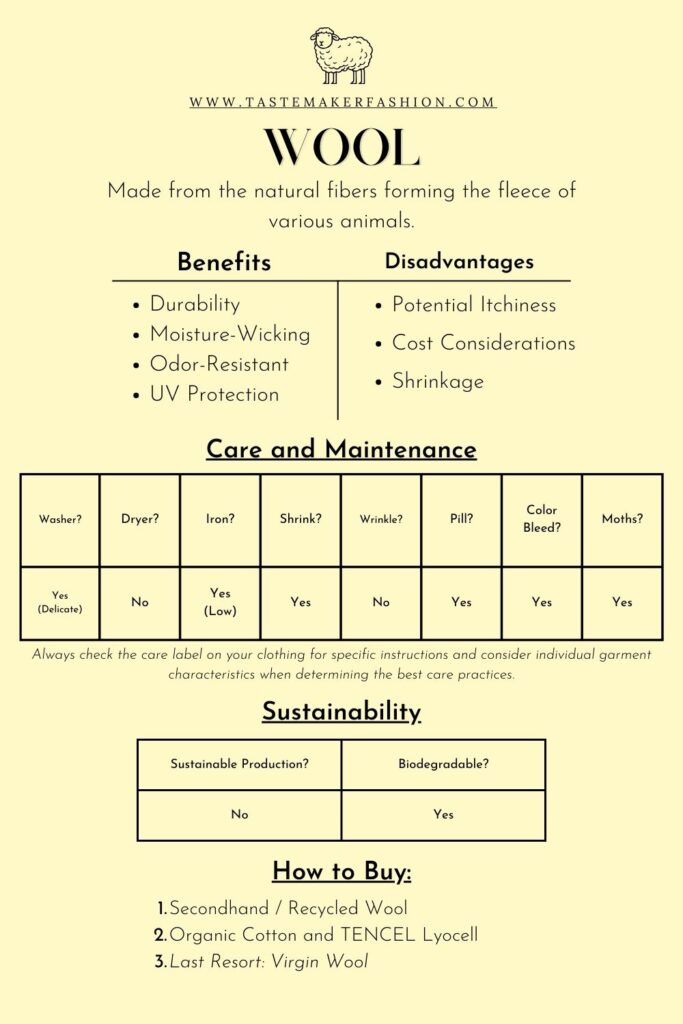
Wool
What is Wool?
Wool, one of the most popular fabrics, is made from the natural fibers forming the fleece of various animals. While sheep are the primary source, wool can also be derived from animals like camels, rabbits, and others. This versatile material has been one of the best clothing fabrics in the industry for centuries, offering a unique blend of qualities that make it a standout choice for various garments.
What are the Benefits of Wool Clothing?
Durability: Compared to other fabrics, wool fibers have a high elasticity which makes them resistant to wear and wear, making it one of the best clothing fabrics to have in your closet. Any woolen garment, with the right care and maintenance, will be sure to last you a long time.
Moisture-Wicking: Wool’s remarkable moisture-wicking capabilities make it one of the most popular fabrics for year-round wear. Whether braving a cold winter day or a warm summer afternoon, wool helps regulate body temperature by efficiently drawing moisture away from the skin, ensuring comfort in diverse weather conditions.
Odor Resistant: The moisture-wicking prowess of wool not only contributes to temperature regulation but also combats odor-causing bacteria. By absorbing up to 35% of its weight in moisture, wool minimizes the development of unpleasant odors, leaving you feeling fresh even after extended wear.
UV Protection: As nature’s sunshield, wool offers excellent protection against harmful UV rays. Boasting an Ultraviolet Protection Factor (UPF) ranging from 20 to 50, wool outperforms cotton shirts, which typically have a UPF rating of 10. This makes wool one of the most popular fabrics for those conscious of sun exposure.
What are the Disadvantages of Wool Clothing?
Potential Itchiness: While high-quality wool is renowned for its softness, some lower-grade variants may cause skin irritation and discomfort. It’s essential to prioritize superior grades and blends to mitigate the risk of itchiness.
Cost Considerations: Quality often comes at a price, and as one of the best clothing fabrics, wool is no exception. Higher-quality wool products may carry a steeper price tag. However, the investment in durability and comfort may outweigh the initial cost, offering long-term value.
Shrinkage: Wool demands careful handling to maintain its integrity. Improper care, such as washing or drying in high temperatures, can lead to shrinkage. Adhering to recommended care guidelines ensures that your wool garments maintain their original size and shape.
How to Care for Wool Clothing:
| Question | Answer |
|---|---|
| Can I put my wool clothing in the washing machine? | While handwashing is the recommended method for caring for wool, machine washing is an option if handled with care. When caring for wool, opt for a very gentle cycle with cold water to minimize the risk of damage to your wool garments. |
| Can I put my wool clothing in the dryer? | No, it is strongly advised to air dry wool instead of using a dryer, particularly for more delicate pieces. Air drying helps maintain the integrity of the fibers and ensures longevity. |
| Can I iron my wool clothing? | Yes, ironing wool is possible, but precautions are essential. Use low heat and place a protective layer between the iron and the garment to prevent damage. |
| Will my wool shrink? | Yes, wool is prone to shrink when exposed to heat during washing or drying. To preserve the size and shape of your wool items, avoid high-temperature water and drying methods. |
| Will my wool wrinkle? | No, wool is not highly prone to wrinkling. Any creases that may occur can be easily steamed out, preserving the smooth and refined appearance of your garments. |
| Will my wool pill? | Yes, wool is susceptible to pilling, especially if the fibers are on the shorter side. Regular maintenance, such as gentle brushing, can help mitigate pilling and keep your wool garments looking pristine. |
| Will my wool bleed in the wash? | Yes, a small amount of dye bleeding is normal during the initial washes of wool garments. To prevent color transfer, wash your wool items separately or with similar colors. |
| Is my wool prone to moths? | Yes, wool is particularly attractive to moths due to its composition of fibrous protein, keratin. Implement preventive measures, such as storage in airtight containers or the use of mothballs, to safeguard your wool items from moth damage. |
Remember, always check the care label on your wool clothing for specific instructions and consider individual garment characteristics when determining the best care practices.
Is wool production sustainable?
The question of whether wool production is sustainable is nuanced. While shearing doesn’t involve the outright killing of animals, the process is not without concerns. Sheep are often selectively bred to maximize wool yield, sometimes leading to fatal consequences due to extreme overheating. Adult female sheep, known as ewes, are subjected to selective breeding for multiple births, with up to 15 million lambs succumbing to winter exposure within the first 48 hours of life. Disturbingly, there are no laws against painful practices such as tail docking and mulesing, performed on lambs without any pain relief.
The environmental toll of wool production is substantial. The greenhouse gas emissions associated with wool are notably high, with a wool knit sweater producing 27 times more emissions than its cotton counterpart. Additionally, the land footprint is staggering, requiring 367 times more land to produce one bale of wool compared to cotton.
Is wool biodegradable?
Despite its environmental drawbacks, wool possesses a redeeming quality—it is biodegradable. Wool garments will naturally decompose within 1 to 5 years, contributing to a more circular and eco-friendly lifecycle.
How to Buy Wool Clothing:
- Recycled Wool or Secondhand Wool: Wool’s inherent durability makes it one of the most popular fabrics for second-hand garments, ensuring that even pre-loved items continue to withstand the test of time with style and resilience. Choosing recycled or secondhand wool reduces the demand for new wool production, lessening the environmental impact.
- Organic Cotton and TENCEL Lyocell: Explore garments made from organic cotton and TENCEL Lyocell, which provide excellent thermal properties without the ethical and environmental concerns associated with conventional wool.
Buy Virgin Wool as a Last Resort: Until more ethical practices are widely adopted in the wool industry, it’s advisable to refrain from purchasing new wool garments. Opting for recycled or alternative materials sends a powerful message in favor of sustainable and humane practices.
Avoid buying Acrylic Wool: It’s advisable to steer clear of acrylic sweaters and jackets, a wool alternative with highly unsustainable production practices and a lack of biodegradability, contributing to environmental concerns over time.
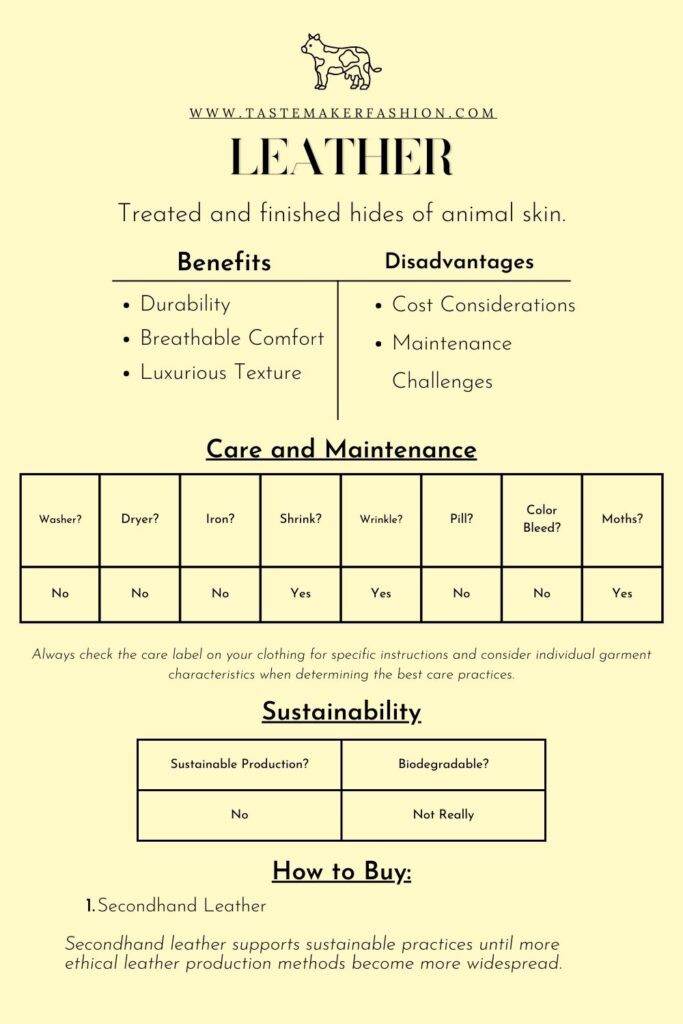
Leather
What is Leather?
Leather, a versatile material, is crafted through an intricate process that involves treating and finishing the hides of animal skin. This meticulous treatment not only ensures durability but also enhances the distinctive qualities that make leather a one of the most popular fabrics for a range of products, from timeless jackets and rugged boots to chic handbags.
While cattle are the primary source of leather, contributing to the majority of production, a smaller yet significant percentage is derived from other animals like sheep, goats, and pigs. Each animal source introduces unique characteristics to the leather, creating a diverse array of textures and finishes that cater to different tastes and preferences in the fashion landscape.
What are the Benefits of Leather Clothing?
Durability: Investing in a leather product ensures a long-lasting addition to your wardrobe, with the potential to endure for decades when provided with proper care.
Breathable Comfort: Leather’s exceptional breathability allows air to circulate, preventing the accumulation of body sweat and odor. This quality not only contributes to comfort but also makes leather an ideal choice for shoes, bags, belts, and jackets, helping regulate body temperature.
Luxurious Texture: Distinctive grain and texture set leather apart from alternative materials as one of the most popular fabrics. Crafted with meticulous attention to detail, leather products exude a luxurious touch that is challenging to replicate.
What are the Disadvantages of Leather Clothing?
Cost Considerations: The extensive process involved in obtaining leather contributes to a higher price point, positioning it as a more expensive option in the world of textiles.
Maintenance Challenges: Caring for leather demands regular attention to keep it looking its best. Unlike everyday fabrics, leather cannot be casually tossed into the washing machine. Special cleaning products and careful protection from elements like sunlight and water are essential for maintaining its integrity.
How to Care for Leather Clothing:
| Question | Answer |
|---|---|
| Can I put my leather clothing in the washing machine? | No, leather is not suitable for the washing machine; it may be subject to irreversible damage. Cleaning leather requires specialized care to maintain its integrity. |
| Can I put my leather clothing in the dryer? | No, leather is not suitable for the dryer and can experience irreversible damage. Air drying is recommended to preserve its natural texture and prevent deformation. |
| Can I iron my leather clothing? | No, ironing is not recommended for leather. The unique qualities of leather make it susceptible to damage when exposed to direct heat. |
| Will my leather shrink? | Yes, exposure to high temperatures can cause leather to shrink. It’s crucial to store and care for leather items away from heat sources. |
| Will my leather wrinkle? | Yes, over time or with improper care, leather can develop wrinkles and creases. Regular maintenance and proper storage can mitigate this effect. |
| Will my leather pill? | No, leather is not prone to pilling, maintaining a smooth and luxurious appearance over extended use. |
| Will my leather bleed in the wash? | If proper cleaning methods are employed, leather is unlikely to bleed dye. Following recommended care guidelines ensures color retention and garment longevity. |
| Is my leather prone to moths? | Yes, leather is particularly attractive to moths due to its fibrous protein, keratin. Employ preventive measures such as proper storage to protect your leather items from moth damage. |
A Step-by-Step Guide to Caring for your Leather Clothing:
Unlike the conventional approach of tossing your clothes in the washer and dryer, cleaning leather demands a more specialized and meticulous process, especially when caring for items like your cherished leather jacket, handbag, or shoes.
- Dust and Oil Removal: Utilize a soft cloth or brush to gently sweep away dust or oil buildup. Employ circular motions to prevent any potential damage to the leather surface.
- Gentle Soapy Solution: Create a cleaning solution by combining warm water with two teaspoons of liquid detergent. The key principle when cleaning leather is to adhere to the less-is-more mantra. Use a soft cloth or sponge to delicately clean the leather with the soapy solution, ensuring the cloth is damp, not excessively wet, and avoiding vigorous rubbing to prevent watermarks.
- Soapy Residue Removal: Wipe down the leather with a fresh cloth dipped in clean water, removing any soapy residue. Employ minimal water to preserve the leather’s integrity.
- Drying Process: Pat the leather dry with a clean, dry towel and allow the item to air dry completely. Avoid using heat sources like hair dryers or exposing the leather to direct sunlight to hasten the drying process.
Additionally, an alternative to the soapy water method is using a specialized leather cleaner for optimal results in maintaining the quality and appearance of your leather products. By following these steps, you ensure that your leather items receive the care they deserve, preserving their longevity and enhancing their timeless appeal.
Remember, always check the care label on your leather clothing for specific instructions and consider individual garment characteristics when determining the best care practices.
Is leather production sustainable?
Leather production is a coproduct (not a byproduct) that goes hand in hand with the meat industry. The two industries raise ethical concerns due to limited regulations and no legal safeguards against mutilation or pain relief. Male calves are slaughtered as little as a week old because their hides create soft leather. The dual-purpose use of animals for meat and leather also contributes to the release of methane, a potent greenhouse gas, exacerbating environmental concerns and climate change.
Transforming animal skin into leather through the tanning process comes with its own set of environmental challenges. This intricate procedure demands substantial energy and relies on hazardous chemicals like formaldehyde, coal-tar derivatives, and cyanide-based oils, dyes, and finishes. Workers and residents near tanneries often face exposure to carcinogenic chemicals, leading to a concerning rise in cancer rates between 20% and 50%.
Is Vegan Leather sustainable?
The answer, unfortunately, is no. In response to growing awareness of the ethical concerns surrounding traditional leather production, some individuals have turned to faux leather as an alternative. Despite being a vegan option, most faux leather is crafted from polyurethane, a material that poses environmental challenges. Understanding the environmental impact of faux leather is essential for making informed decisions about sustainable and ethical fashion choices.
Is leather biodegradable?
Despite being biodegradable, the processed nature of leather, coupled with chemical treatments during tanning, extends its decomposition timeline to a staggering 50 to 100 years. While leather will eventually break down, the prolonged duration raises questions about its true environmental impact and sustainability.
How to Buy Leather Clothing:
Secondhand Leather: Secondhand leather, as one of the most popular fabrics, supports sustainable practices until more ethical leather production methods become more widespread. Opting for second-hand leather not only aligns with a conscientious approach to fashion but also leverages the durability of leather, ensuring a long-lasting wardrobe addition.
Semi-Synthetic Fabrics
Understanding the Difference Between Viscose, Modal, and Lyocell
Understanding the nuances of semi-synthetic fabrics can be a complex journey, especially when it comes to distinguishing between Viscose, Modal, and Lyocell. These most popular fabrics represent different cellulose generations, each with its unique properties and history.
First Generation: Viscose/Rayon
Invented in 1892, Viscose quickly gained popularity, becoming a commercial success by the turn of the century.
Second Generation: Modal
Introduced in 1951, Modal stands as an advancement over traditional Viscose, undergoing an additional process to create a more robust fiber.
Third Generation: Lyocell
Developed in 1972, Lyocell marks the latest breakthrough in cellulose fabric technology. Renowned for its wearability benefits and minimal environmental impact, Lyocell represents a sustainable choice in the textile landscape.
What is TENCEL Modal and TENCEL Lyocell?
Originating from the Austrian company Lenzing AG, TENCEL is the trademarked name associated with TENCEL Lyocell and TENCEL Modal materials. Lenzing has established itself as a trusted brand committed to sustainable production practices, encompassing responsible tree farming and closed-loop systems.
It’s crucial to note that Lenzing specializes in producing yarns, not textiles. While TENCEL materials boast eco-friendly credentials, the overall environmental impact extends to fabric production and clothing manufacturing. Therefore, consumers should seek brands that not only use Lenzing or TENCEL materials but also adhere to sustainable manufacturing practices, emphasizing transparency in their processes.
Navigating the world of semi-synthetic fabrics involves understanding the distinctions between Viscose, Modal, and Lyocell. TENCEL Modal and TENCEL Lyocell emerge as beacons of sustainability within this realm, provided consumers make informed choices by supporting brands committed to eco-friendly manufacturing practices.
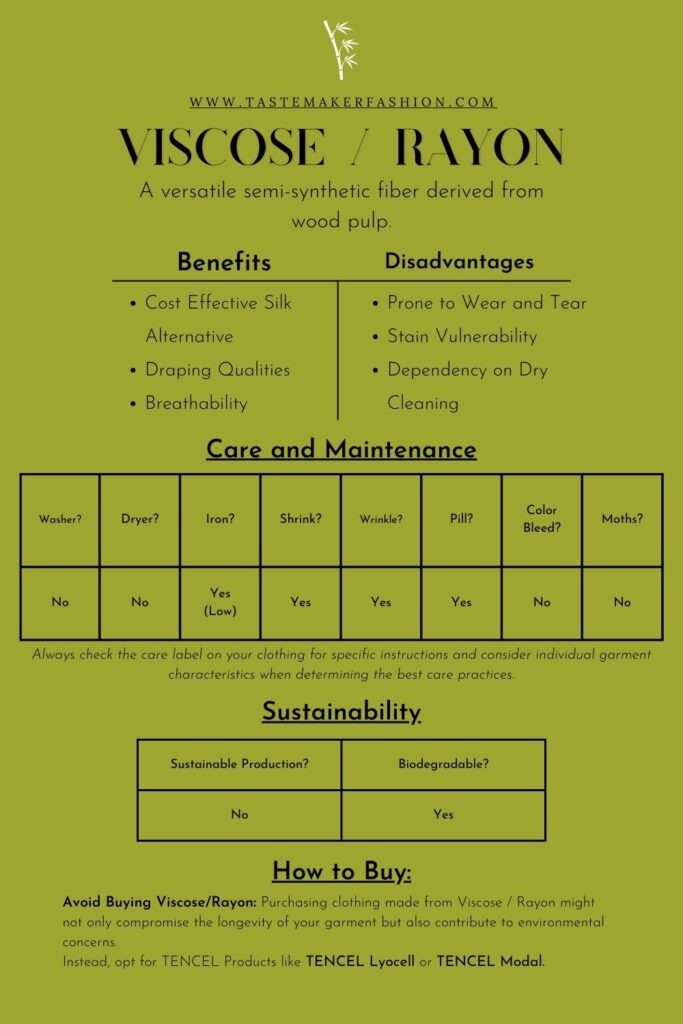
Viscose / Rayon
What is Viscose / Rayon:
Viscose, also known as rayon, stands as one of the most popular fabrics as a versatile semi-synthetic fiber derived from wood pulp sourced from various plants such as eucalyptus, beech, pine, and bamboo. Despite its technical classification as a synthetic fabric, its origins lie in organic matter, undergoing a meticulous process that transforms plant cellulose into fibers suitable for textile production.
What are the Benefits of Viscose Clothing?
Cost-Effective Silk Alternative: Viscose presents an economical alternative to silk, one of the most popular fabrics, offering a comparable luxurious look and feel without the hefty price tag.
Draping Qualities: For garments requiring a fluid or draped appearance, Viscose excels in holding a graceful drape, enhancing the overall aesthetic of the garment.
Breathability: Renowned for its breathability, Viscose emerges as an ideal choice for warm weather seasons and climates, ensuring comfort without compromising style.
What are the Disadvantages of Viscose Clothing?
Prone to Wear and Tear: Despite its aesthetic appeal as one of the most popular fabrics, Viscose fibers lack the durability of some natural counterparts, making them susceptible to wear and tear, particularly when exposed to water. Instances of stretching and bagging may occur, with limited recovery over time.
Stain Vulnerability: Viscose’s absorbent nature makes it prone to stains from body oils and water. Spot cleaning, unfortunately, can exacerbate the issue, potentially resulting in permanent markings on the fabric.
Dependency on Dry Cleaning: Due to the delicate nature of its fibers when exposed to water, Viscose typically necessitates dry cleaning. This maintenance requirement is essential to preserve the fabric’s integrity and longevity.
How to Clean Viscose Clothing:
| Question | Answer |
|---|---|
| Can I put my viscose clothing in the washing machine? | No, it is strongly recommended to take your viscose clothing to the dry cleaner or handwash for optimal viscose care. |
| Can I put my viscose clothing in the dryer? | No, it is advisable to steer clear of the dryer. Instead, opt for air drying to maintain the integrity of your viscose garments. |
| Can I iron my viscose clothing? | Yes, you can iron your viscose clothing inside-out, using a low-heat setting similar to silk. |
| Will my viscose clothing shrink? | Yes, proper care is essential to prevent shrinkage, as viscose clothing can shrink up to 25% during the initial wash if not handled with care. |
| Will my viscose clothing wrinkle? | Yes, be prepared for some wrinkling, as viscose clothing has a natural tendency to develop wrinkles. |
| Will my viscose clothing pill? | Yes, compared to other synthetic fabrics, viscose clothing is more prone to pilling. Taking preventive measures can help maintain the fabric’s smooth appearance. |
| Will my viscose bleed when washed? | No, generally, viscose clothing retains its color well and is less likely to bleed during washing. |
| Is my viscose prone to moths? | Not as much as other keratin protein fibers. While viscose is less attractive to moths, it’s crucial to store your clothing in a clean, well-sealed environment to prevent any potential damage. |
Remember, always check the care label on your viscose clothing for specific instructions and consider individual garment characteristics when determining the best care practices.
Is viscose production sustainable?
Viscose production raises critical questions regarding its sustainability, encompassing two pivotal areas of concern.
Viscose’s journey from wood pulp to textile involves a chemical-intensive process, contributing to environmental pollution. Notably, the use of carbon disulfide, a highly toxic chemical, poses risks to both workers and surrounding ecosystems. Exposure to this chemical can result in adverse health effects, including dizziness, headaches, weight loss, and harm to respiratory and cardiovascular systems.
The raw material for viscose, wood pulp, often originates from endangered forests, leading to detrimental deforestation. This not only erases ancient forests but also devastates habitats crucial for endangered species and Indigenous communities. The ecological toll of such practices underscores the urgent need for sustainable sourcing in the viscose production supply chain.
Is viscose biodegradable?
Despite its questionable production practices, viscose exhibits biodegradability. Derived from natural resources, this man-made fabric is considered biodegradable and typically decomposes fully within approximately six weeks. However, the speed of decomposition should not overshadow the pressing need for sustainable practices in the production phase to mitigate the broader environmental impact of viscose.
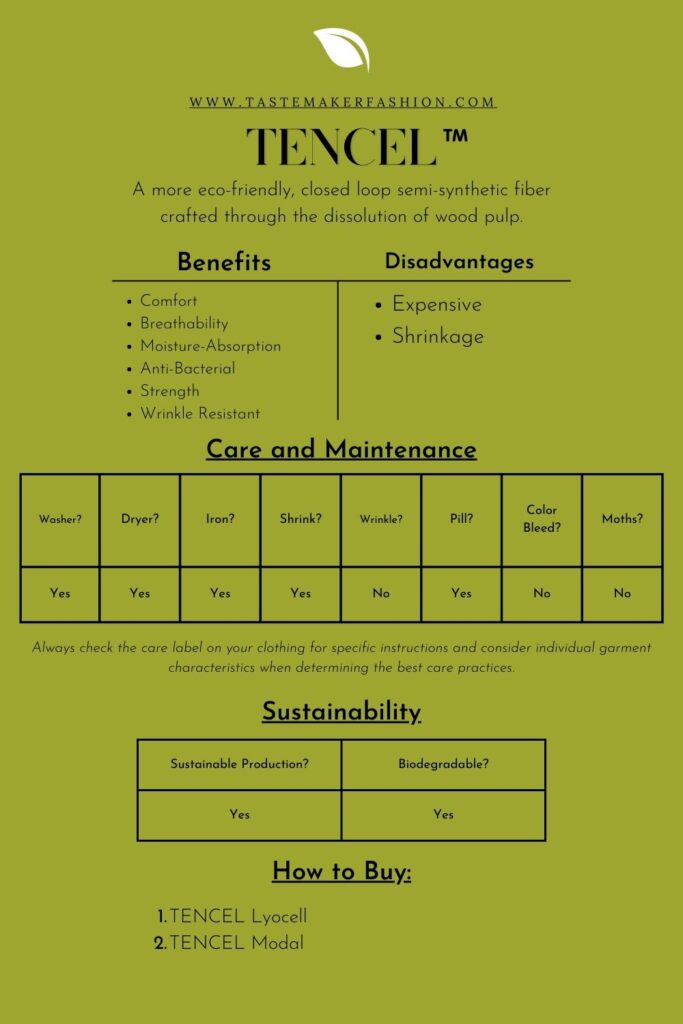
TENCEL Lyocell and TENCEL Modal
What is TENCEL?
Similar to Viscose, TENCEL is a semi-synthetic fiber crafted through the dissolution of wood pulp in a solvent, ultimately transformed into textile-ready fiber strands. In the case of Lenzing’s TENCEL, eucalyptus wood undergoes a meticulous process where it is broken down into chips and immersed in direct chemical solvents for pulp creation.
Unlike traditional viscose production, these direct solvents induce minimal chemical changes to the cellulose structure, resulting in a production method with a reduced environmental impact in terms of energy consumption and waste generation.
What are the Benefits of TENCEL Clothing?
Comfortable: Thanks to its fine fibers, TENCEL boasts as one of the best clothing fabrics with a softness that rivals, if not surpasses, that of cotton. Its comfort remains even after numerous cycles through the washer and dryer.
Breathability: TENCEL actively aids in maintaining and regulating body temperature, ensuring a cool and comfortable feel, especially in warmer climates.
Moisture Absorption: According to the Lenzing website, TENCEL has the remarkable ability to absorb moisture up to 50% more than cotton, making it one of the best clothing fabric for activewear enthusiasts seeking optimal comfort during physical activities.
Anti-Bacterial: The inherent antibacterial properties of TENCEL contribute to the prevention of bacterial growth, extending the freshness of your clothes over an extended period.
Strength: In stark contrast to viscose, TENCEL’s robust fibers withstand the rigors of both washer and dryer, eliminating the need for specialized dry cleaning.
Wrinkle-Resistant: TENCEL remains effortlessly smooth even after being scrunched up for an extended duration.
What are the Disadvantages of TENCEL Clothing?
Expensive: The use of advanced processing technologies elevates the cost of TENCEL. However, this higher price tag reflects a commitment to superior quality, durability, and sustainability.
Shrinkage: TENCEL may experience up to a 5% shrinkage if not cared for properly. Mitigate this risk by opting for lower temperatures during the washing and drying process.
How to Care for TENCEL Clothing:
| Question | Answer |
|---|---|
| Can I put my TENCEL in the washing machine? | Yes, you can, but it’s advisable to care for your TENCEL by washing it at a lower temperature to mitigate the risk of shrinkage. |
| Can I put my TENCEL clothing in the dryer? | Yes, you have the option to either air dry your TENCEL garments or use a low setting on the dryer. |
| Can I iron my TENCEL clothing? | Yes, in the event of wrinkles, use a low heat setting or the steam setting on your iron to maintain the fabric’s integrity. |
| Will my TENCEL clothing shrink? | Yes, improper care can lead to garments shrinking up to 5%. To prevent this, it’s crucial to wash and dry your clothing at lower temperatures. |
| Will my TENCEL clothing wrinkle? | No, TENCEL garments exhibit a lower tendency to wrinkle, contributing to their overall convenience and polished appearance. |
| Will my TENCEL clothing pill? | Yes, TENCEL may be more susceptible to pilling over time. However, with proper care, you can minimize the occurrence of pilling. |
| Will my TENCEL bleed when washed? | No, TENCEL is known for effectively holding dyes. However, it’s recommended to separate colors during the first few washes to ensure color retention. |
| Is my TENCEL prone to moths? | Not as much as other keratin protein fibers. While TENCEL is less attractive to moths, it remains essential to store your clothing in a clean, well-sealed environment to prevent any potential damage. |
Remember, always check the care label on your TENCEL clothing for specific instructions and consider individual garment characteristics when determining the best care practices.
Is TENCEL production sustainable?
TENCEL production stands as a beacon of sustainability, making it one of the best clothing fabrics and outshining other fabrics such as viscose. TENCEL wood is often derived from responsibly managed forests, earning certification from the Forest Stewardship Council (FSC). This strategic approach mitigates the impact on ecosystems and eliminates contributions to deforestation.
In stark contrast to viscose production, TENCEL utilizes non-toxic solvents in its wood breakdown process. Operating within a closed loop system, 99% of these solvents are recycled and reused, minimizing environmental pollution compared to traditional methods.
TENCEL fibers emerge in a pristine white, eliminating the need for extensive bleaching processes. This not only contributes to a reduction in environmental impact but also enhances dye retention, requiring less water in the coloring process compared to fabrics like cotton or linen.
TENCEL’s production journey aligns with sustainability principles by sourcing wood responsibly, utilizing non-toxic solvents, and minimizing the need for harsh chemical treatments. Choosing TENCEL not only ensures a luxurious and comfortable fabric but also reflects a conscious decision to support environmentally friendly practices.
Is TENCEL biodegradable?
Yes, because it is made from natural resources, TENCEL is biodegradable. This means that once discarded, TENCEL will decompose within a matter of months.
How to Buy Semi-Synthetic Clothing:
- TENCEL Lyocell: TENCEL Lyocell stands as the top choice. Renowned for its exceptional wearability and eco-friendly production practices, it makes it one of the best clothing fabrics for sustainability.
- TENCEL Modal: Following closely is TENCEL Modal, offering a favorable blend of comfort and sustainability. While slightly different from Lyocell, Modal remains a commendable choice in the realm of semi-synthetic fabrics.
Avoid buying Viscose / Rayon: These fabrics, despite its silk-like appeal, comes with wearability disadvantages and is produced through unsustainable processes. Purchasing clothing made from Viscose / Rayon might not only compromise the longevity of your garment but also contribute to environmental concerns.
Additional Considerations:
While TENCEL is a sustainable choice, exercise caution when opting for fabrics that blend TENCEL with other materials. Some blends may include synthetic polyester or nylon, diluting the eco-friendly attributes of TENCEL.
Synthetic Fabrics
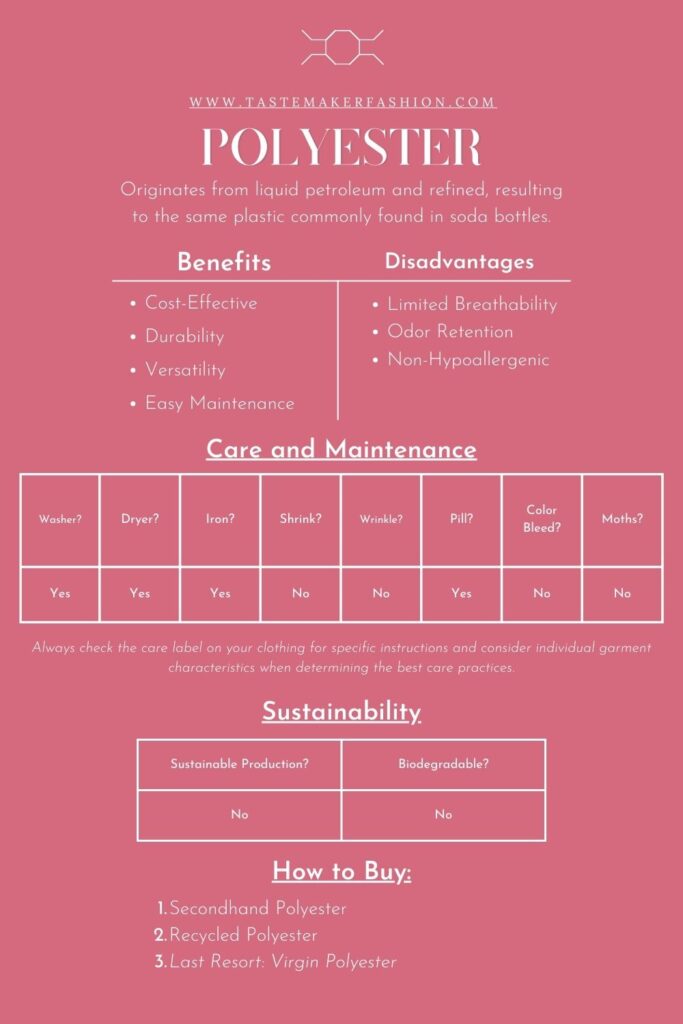
Polyester
What is Polyester?
Polyester is the world’s most popular fabric and originates from the depths of the Earth’s surface in the form of liquid petroleum. Extracted and refined, this petroleum undergoes a transformative process that involves combining two monomers, ethylene, and p-xylene, with additional chemicals. This amalgamation ultimately results in the creation of polyethylene terephthalate (PET), the same plastic commonly found in soda bottles. The PET is then extruded through spinnerets, evolving into thread, which is subsequently spun together to form yarn—a crucial component in the production of synthetic fabric.
What are the Benefits of Polyester Clothing?
Cost-Effective: One of polyester‘s biggest attributes as one of the most popular fabrics is its cost efficiency. The production of polyester proves significantly more economical than many alternative materials, resulting in affordable garments for consumers.
Durability and Resilience: Polyester’s strength lies in its long, robust threads, making it exceptionally durable. Its inherent elasticity allows it to maintain its shape, preventing stretching and ensuring a longer garment lifespan.
Versatility: The combination of durability and elasticity renders polyester a versatile fabric, suitable for a wide array of garments. Its popularity in various clothing types attests to its adaptability and popularity.
Easy Maintenance: Polyester proves to be a fabric of convenience, as it can withstand higher washing and drying temperatures. Furthermore, its wrinkle-resistant nature eliminates the need for frequent ironing after laundering.
What are the Disadvantages of Polyester Clothing?
Limited Breathability: A downside to polyester is its lack of breathability. The tight arrangement of polyester threads impedes airflow, causing the fabric to trap heat. This can lead to discomfort for the wearer, especially in warmer climates where the fabric may cling to sweaty skin.
Odor Retention: The non-breathable nature of polyester contributes to another drawback—odor retention. The fabric tends to hold onto body odors, resulting in more frequent washing to prevent unpleasant smells.
Non-Hypoallergenic: Polyester’s composition, infused with plastic chemicals, raises concerns about potential skin allergies and rashes. Some individuals worry about the long-term effects of wearing plastic-based fabrics throughout their lives.
How to Care for Polyester Clothing:
| Question | Answer |
|---|---|
| Can I put my polyester in the washing machine? | Yes, you can care for your polyester with the washing machine, and capable of regular laundering without compromising its integrity. |
| Can I put my polyester clothing in the dryer? | Yes, you can use the dryer for your polyester clothing. It stands up well to regular drying conditions. |
| Can I iron my polyester clothing? | Yes, polyester garments can be ironed at a medium heat setting, offering flexibility in maintaining a polished appearance. |
| Will my polyester clothing shrink? | No, polyester retains its original size and shape while washing and drying. |
| Will my polyester clothing wrinkle? | While full polyester pieces are generally wrinkle-resistant, it’s essential to note that polyester blends, such as poly-cotton, may exhibit some wrinkling after laundering. |
| Will my polyester clothing pill? | Yes, polyester, being a synthetic material, is susceptible to pilling. Regular care and gentle washing can help minimize this tendency. |
| Will my polyester bleed when washed? | No, polyester exhibits superior color retention compared to natural materials, ensuring that your garments are less likely to bleed or fade during washing. |
| Is my polyester prone to moths? | No, unlike animal-based materials, polyester does not attract moths, providing a moth-resistant quality that contributes to the longevity of your clothing. |
Remember, always check the care label on your polyester clothing for specific instructions and consider individual garment characteristics when determining the best care practices.
Is polyester production sustainable?
Polyester, a widely utilized synthetic fabric, faces significant challenges in terms of sustainability. Its primary ingredient, petroleum, is a non-renewable resource, and predictions indicate its depletion by the end of the century. The extraction and refinement processes contribute to environmental degradation and the depletion of finite fossil fuel reserves. The production of polyester involves the use of various chemicals, some of which can be harmful to ecosystems.
The production of polyester also results in the burning of fossil fuels, contributing to high levels of greenhouse gas emissions. This not only exacerbates climate change but also poses a challenge in mitigating the impacts of global warming, creating a critical tipping point.
Polyester’s environmental impact extends beyond production. When polyester textiles are laundered, they release microplastics into water systems, eventually reaching oceans and entering the food chain.
Is polyester biodegradable?
Polyester’s lack of biodegradability compounds environmental concerns. With a degradation timeline stretching over 200 years, the material is poised to persist in landfills, potentially leaching harmful substances into the ground and contributing to pollution.
How to Buy Polyester Clothing:
- Secondhand Polyester: Explore second-hand stores for polyester garments. Polyester, as one of the world’s most popular fabric and its inherent durability makes it an excellent candidate for secondhand fashion. By choosing pre-owned polyester items, you extend the lifespan of the material and reduce the demand for new production, aligning with principles of reuse and sustainable consumption.
- Recycled Polyester: Opt for products made from recycled polyester. This material is sourced from post-consumer plastic bottles, diverting plastic waste from landfills and reducing the demand for new raw materials. Embracing recycled polyester contributes to a circular economy and minimizes environmental impact.
Buy Virgin Polyester as a Last Resort: Opting to avoid virgin polyester is advisable due to its unsustainable production, reliance on non-renewable resources like petroleum, and its non-biodegradable nature, contributing to long-lasting environmental impacts during disposal.
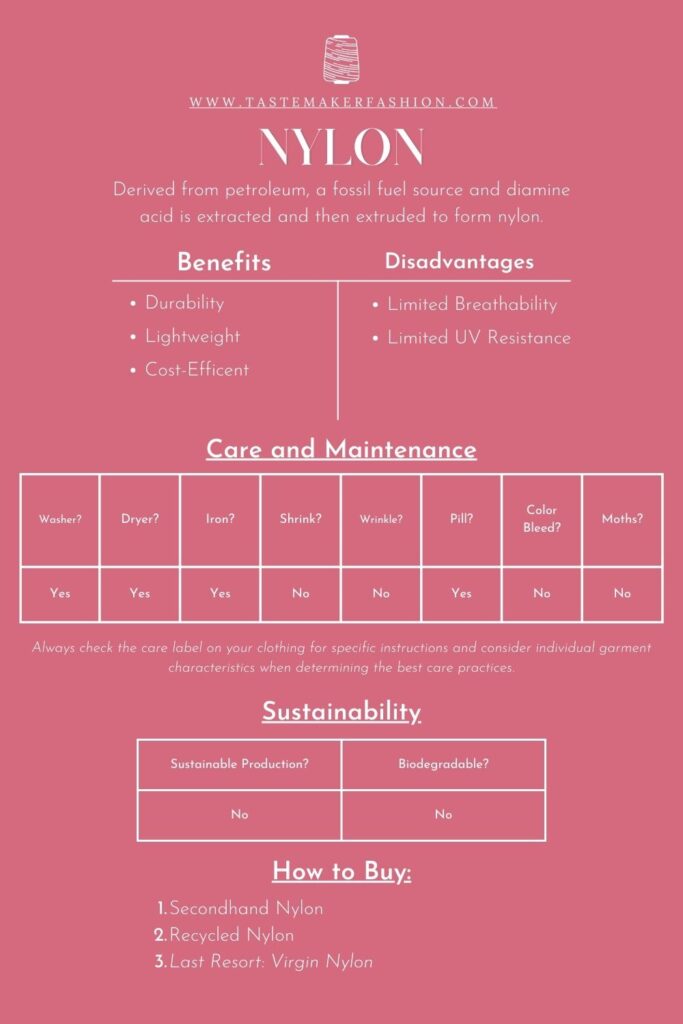
Nylon
What is Nylon?
Nylon, similar to Polyester, is derived from petroleum, a fossil fuel source. However, what sets Nylon apart is the extraction process of its monomers. Specifically, diamine acid is extracted from crude oil and subsequently combined with various chemicals to form a polymer known as nylon salt. Comparable to the production of polyester, this nylon polymer is then extruded through a spinneret, ultimately resulting in the creation of nylon yarn, which is further transformed into one of the world’s most popular fabrics.
What are the Benefits of Nylon Clothing?
Durability: Originally developed for exclusive military use during World War II, nylon displays exceptional wear and abrasion resistance. As one of the most popular fabrics, its durability remains a standout feature, making it a reliable choice for a variety of applications.
Lightweight: Weighing only 1/7th of other common fabric materials, nylon emerges as an ideal option for creating lightweight yet sturdy pieces. This characteristic makes it particularly appealing for garments and items where a balance between strength and weight is crucial.
Cost-Efficiency: Nylon proves significantly more cost-effective to produce. The resulting savings are reflected in the affordability of nylon-based products, offering consumers a budget-friendly alternative.
What are the Disadvantages of Nylon Clothing?
Lack of Breathability: While nylon excels in durability, its wearability in hot summer conditions can be limiting. The fabric tends to trap moisture, creating a stifling sensation for the wearer. This lack of breathability may influence its suitability for certain climates and activities.
Limited UV Resistance: Over time, exposure to sunlight can lead to fading or yellowing of nylon fabric. Additionally, prolonged exposure weakens the material. This lack of UV resistance suggests that careful consideration is needed when choosing nylon for items intended for prolonged outdoor use.
How to Care for Nylon Clothing:
| Question | Answer |
|---|---|
| Can I put my nylon in the washing machine? | Yes, nylon stands up well to machine washing, offering nylon care convenience in your laundry routine. |
| Can I put my nylon clothing in the dryer? | Yes, nylon products can go in the dryer but opt for a lower temperature setting to preserve the fabric’s integrity and extend the life of your clothing. |
| Can I iron my nylon clothing? | Yes, you can iron your nylon clothing but exercise caution by setting the iron to a low temperature to prevent damage to the material. |
| Will my nylon clothing shrink? | No, nylon will not shrink in the laundry but with garments blended with other materials, exercise caution and follow care instructions to maintain their original size. |
| Will my nylon clothing wrinkle? | No, nylon exhibits impressive wrinkle resistance, saving you time and effort on ironing. |
| Will my nylon clothing pill? | Yes, nylon may develop pills over time. Handle your garments with care to mitigate this common occurrence. |
| Will my nylon bleed when washed? | No, nylon exhibits excellent color retention during washing. |
| Is my nylon prone to moths? | No, unlike animal-based materials, nylon does not attract moths, providing a moth-resistant quality that contributes to the longevity of your clothing. |
Remember, always check the care label on your nylon clothing for specific instructions and consider individual garment characteristics when determining the best care practices.
Is nylon production sustainable?
Regrettably, nylon production, much like other synthetic materials, does not include sustainable production practices. The production process contributes to environmental concerns, notably through the emission of nitrous oxide—a greenhouse gas that is a staggering 300 times more potent than carbon dioxide. The long atmospheric lifespan of nitrous oxide, lingering for 110 years, poses a substantial threat to our ozone layer, exacerbating the environmental impact of nylon production.
The environmental toll extends beyond gas emissions. The production of nylon is resource-intensive, demanding significant quantities of water for the cooling process. Additionally, a substantial amount of energy is consumed during production, further contributing to the ecological footprint of this widely used synthetic material.
Is nylon biodegradable?
Despite its eventual decomposition, nylon, much like its synthetic counterparts, is far from being a model of biodegradability. The process can take close to 200 years, signifying a prolonged environmental impact and underscoring the challenges associated with managing the life cycle of synthetic materials.
How to Buy Nylon Clothing:
- Recycled Nylon or Secondhand Nylon: The inherent durability of nylon ensures that even after the end of its first life cycle, these products remain robust and functional. As one of the world’s most popular fabrics, opting for secondhand nylon items extends the lifespan of the material, minimizing the demand for new production and contributing to a more sustainable, circular economy.
Buy Virgin Nylon as a Last Resort: It’s important to acknowledge the environmental drawbacks associated with the production of virgin nylon. The process not only falls short in terms of sustainability but actively contributes to environmental degradation. As conscientious consumers, avoiding the purchase of virgin nylon aligns with sustainable practices and serves as a small but impactful step towards mitigating its environmental impact.
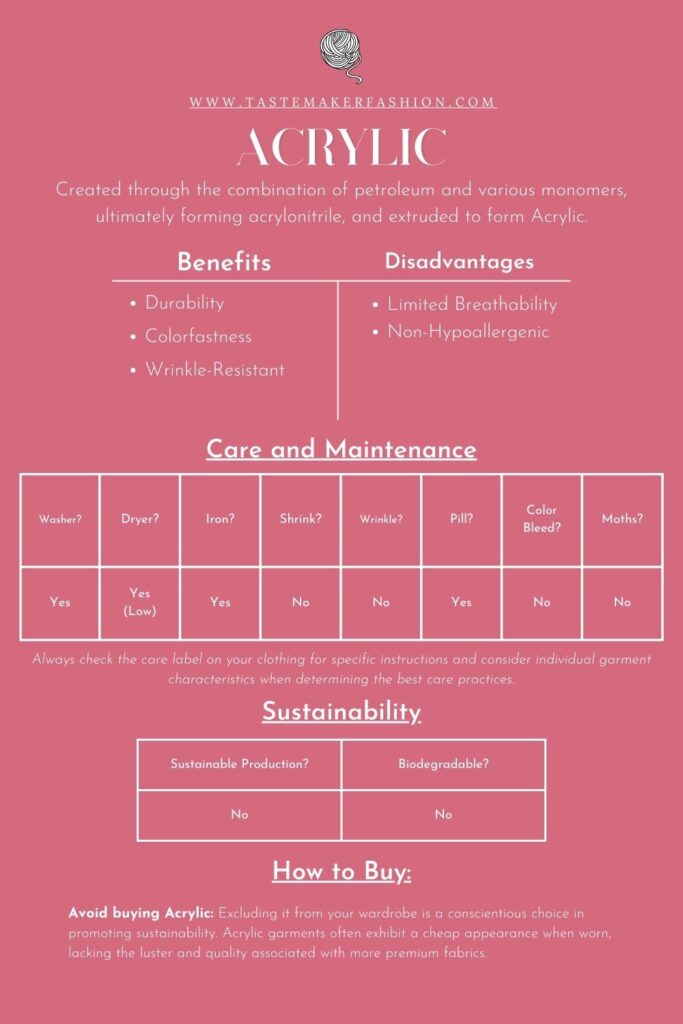
Acrylic
What is Acrylic?
Acrylic, a synthetic textile, is created through the combination of petroleum and various monomers, ultimately forming acrylonitrile. This polymer, in turn, is transformed into threads and woven into what we commonly recognize as acrylic, one of the most fabrics used in clothing.
What are the Benefits of Acrylic Clothing?
Durability: As one of the most popular fabrics, Acrylic displays notable strength, exhibiting high resistance to both abrasion and tearing.
Colorfastness: Retaining its vibrant hues even after numerous washes, acrylic fabrics stand out for their ability to hold color without bleeding or fading. This quality is particularly beneficial for maintaining the vividness of brightly colored clothing.
Wrinkle-Resistant: Acrylic fabrics demonstrate an inherent resistance to creasing and wrinkling, making them a convenient choice for individuals averse to ironing.
What are the Disadvantages of Acrylic Clothing?
Limited Breathability: Like many synthetic fibers, acrylic tends to trap heat close to the body and lacks effective air circulation. While this characteristic makes it suitable for cooler seasons, it may result in discomfort during warmer weather, potentially leading to increased perspiration.
Non-Hypoallergenic: The chemicals used in the production of acrylic fabric may cause skin irritations or allergic reactions. As a result, individuals with sensitivities or allergies may find it important to exercise caution when considering garments made from acrylic.
How to Care for Acrylic Clothing:
| Question | Answer |
|---|---|
| Can I put my acrylic in the washing machine? | Yes, machine washing is suitable for acrylic garments. However, steer clear of hot water, as high temperatures can cause acrylic to stretch. When caring for acrylic clothing, opt for a gentle cycle with lukewarm or cold water for optimal results. |
| Can I put my acrylic clothing in the dryer? | Certainly, but exercise caution with hot temperatures, as they may lead to overstretching. It’s advisable to choose a low-heat setting or air-dry your acrylic items to preserve their shape. |
| Can I iron my acrylic clothing? | Yes, you can iron your acrylic clothing but refrain from using high temperatures. Use the steam feature or place a cloth between the iron and the fabric to prevent damage. |
| Will my acrylic shrink? | No, acrylic maintains its shape and is resistant to shrinking. However, be mindful of high temperatures, as excessive heat can contribute to stretching. |
| Will my acrylic wrinkle? | No, acrylic is known for its wrinkle-resistant nature. It maintains a smooth appearance even after washing, eliminating the need for excessive ironing. |
| Will my acrylic pill? | Yes, be aware that acrylic fibers are susceptible to pilling so handle your garments with care to minimize this effect. |
| Will my acrylic bleed when washed? | No, acrylic fabrics typically retain color well during washing, ensuring minimal color bleeding. |
| Is my acrylic prone to moths? | No, unlike certain animal-based materials, acrylic does not attract moths. |
Remember, always check the care label on your nylon clothing for specific instructions and consider individual garment characteristics when determining the best care practices.
Is acrylic production sustainable?
Unfortunately, the production of acrylic is not deemed environmentally sustainable. The Centers for Disease Control and Prevention (CDC) highlights potential health hazards associated with acrylonitrile, a key component in acrylic production. Individuals close to this industry may experience adverse effects on the eyes, skin, lungs, and nervous system. Moreover, neighboring communities near acrylonitrile-producing factories are also impacted.
While the health impacts may not be as directly felt by those wearing acrylic clothing, it’s crucial to recognize that acrylic contributes significantly to the issue of microplastic pollution in oceans. Studies reveal that acrylic releases nearly 730,000 tiny synthetic particles per wash, surpassing even polyester in a microplastic release. This raises concerns about the environmental footprint of acrylic, urging consumers to consider the broader consequences of their clothing choices.
Is acrylic biodegradable?
Regrettably, like many synthetic materials, acrylic faces challenges in terms of biodegradability. It is anticipated to decompose over a lengthy period, close to 200 years. This emphasizes the need for thoughtful consideration of alternative, more sustainable textile choices.
How to Buy Acrylic Clothing:
Avoid buying Acrylic Clothing: Even though Acrylic is one of the most popular fabrics, opting to exclude it from your wardrobe is a conscientious choice in promoting sustainability and enhancing your overall style. Purchasing virgin acrylic contributes to environmental concerns as its production is associated with adverse effects on both human health and marine ecosystems.
Beyond its environmental impact, the aesthetic aspect is worth considering. Virgin acrylic garments often exhibit a cheap appearance when worn, lacking the luster and quality associated with more premium fabrics. By steering clear of adding acrylic to your wardrobe, you not only make a positive statement for sustainable fashion but also elevate the visual appeal of your clothing choices.
